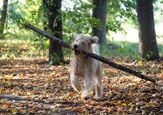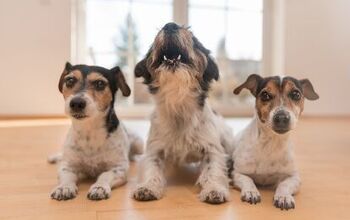How Can I Make My Home Safe for a Blind Dog?

When faced with the news that our best friend is blind or losing their vision, it’s natural to be concerned or even feel overwhelmed. You may worry about how they’ll navigate their world, find their food, or even enjoy their daily routines. However, we have good news. Many blind or visually impaired dogs live long, happy, confident lives.
Vision loss doesn’t change your dog’s ability to be truly happy; it just shifts how they experience the world, relying more on their other incredible senses. In this article, I’ll share how you can set up your home in a way that will keep your blind or visually impaired safe while also boosting their independence and overall well-being. With these tips, you’ll be able to create a space that will help your dog thrive!
Blind from Birth vs. Vision Loss Later in Life
Before making any significant modifications to your home, it’s helpful to understand your dog’s journey. After all, the needs of a dog who has always been blind can differ significantly from those of one who is losing their vision later in life. While many adaptations will benefit all blind dogs, recognizing your dog’s unique needs and challenges will help you tailor your efforts to provide the best support.
Despite the differences in these two experiences, I want to stress that all blind dogs can lead happy, healthy, and fulfilling lives. They may look a little different as you make adjustments with their safety and comfort in mind, but it is possible!
The “Always Blind” Dog
Dogs born without sight or who lose it early in life (as a young puppy) often adapt naturally as they grow. Why? Navigating the world without their vision is their normal. If they have never experienced sight, they don’t miss it and don’t need to change how they approach their daily routine.
They grow up relying more heavily on their sense of smell, hearing, and touch to learn about and explore their surroundings. Any training and obedience is tackled with this lack of sight in mind, meaning they don’t have to relearn their basic commands or how to communicate with their people. Instead, they learn to follow clear verbal cues confidently. Like all dogs, they benefit from a steady and predictable routine.
The confidence of an “always blind” dog largely stems from never knowing anything different, learning how to adjust to their environment early, and relying on consistent routines.
The “Losing Vision” Dog
Vision loss later in life can be more challenging to navigate, both for the dog and the dog parent. The reason is that your dog will now have to transition to a new normal, making many changes to the routine they are used to. Vision loss can impact some of the most basic aspects of a dog’s daily life.
Vision loss can be gradual, due to conditions such as Progressive Retinal Atrophy (PRA) or cataracts, or sudden, as in some cases of glaucoma or Sudden Acquired Retinal Degeneration Syndrome (SARDS). This transition can cause confusion, anxiety, fear, or even signs of depression as your dog’s world begins to change. They may bump into familiar objects, become hesitant to move, or seem disoriented in the home where they were once comfortable.
You will need to offer your dog patience and reassurance as you slowly introduce new ways of navigating their day-to-day life. This includes adjustments to your routine, as well as to your home, to accommodate your dog’s changing needs. They will need your support as they grieve the loss of their sight and develop new coping mechanisms.
Your veterinarian is also an essential part of this journey. They will work to identify the cause of the vision loss, explore any potential treatments, and help you manage any pain or discomfort that may be associated with it.
Creating a Safe Home Environment
One of the most important considerations in giving your blind dog a high-quality life is providing them with a safe, comfortable, and predictable home environment. You can help them learn how to move with confidence and independence by assisting them to create a mental map of the space with consistent sensory input (through touch, scent, and sounds).
Consistency for Success
A fundamental rule for living with a blind dog is never to move furniture. Once they have built a detailed mental map of the home, they will use it to navigate furniture, walls, and other obstacles. They memorize the layout and learn how to move through it safely. Every time you move a piece of furniture, you disrupt this map, causing confusion, anxiety, and potential bumps or injuries.
Explain the importance of this consistency to all family members. Ensuring everyone is on the same page will help prevent miscommunications and unnecessary challenges.
If you need to move something, create a plan to transition your dog safely and smoothly. Temporarily guide your dog around the new placement until they have remapped the space and can confidently navigate the new layout on their own. For significant changes, consider temporarily restricting your dog’s access to a smaller, familiar area and gradually expanding their access as they become familiar with the space.
Navigating Stairs
Stairs are one of the most significant safety risks for blind dogs. Falling down a flight of stairs can cause a serious injury. But unlike their sighted counterparts, they can’t see where that first step begins. Luckily, there are ways to limit your dog’s access and keep them safe.
Installing a sturdy, securely mounted safety gate at the top and bottom of all staircases ensures they will only navigate that challenge when you’re by their side to help. Pay careful attention to the details of the gates you are considering. You need to choose one that’s tall enough that your dog can’t jump over and strong enough to hold up to their weight, even if they lean against them.
If you have elevated areas within your home (such as a bed or couch) that your dog needs to navigate, or outdoor steps that cannot be avoided, a ramp can be a game changer. You can build large ramps for bigger outdoor staircases or purchase a reliable ramp designed for use with furniture. Introduce ramps slowly and with positive reinforcement, helping your dog learn how to carefully move up and down them without slipping off the side. If they are struggling, consider installing a rail to guide their movement.
Other Hazards in the Home
To identify other potential hazards in your home, try getting down and looking through the space at their eye level. Look for sharp corners, low-hanging objects, or fragile items that could be knocked over and cause injury. Here are some tips to address these concerns:
- Furniture Corners: Soft corner protectors can be a lifesaver, preventing painful knocks to your dog’s head or body while moving past sharp edges. You can also DIY your own “bumper” using a pool noodle.
- High-Traffic Areas: Place soft rugs or runners in areas where your dog moves frequently, such as hallways, entryways, and living spaces, especially if you have hard flooring. This will provide better traction and a softer landing if they stumble.
- Keep Things Clutter-Free: Make it a habit to keep floors free of shoes, bags, toys, laundry, and any other items that could become an unexpected tripping hazard.
- Prioritize Essential Routes: Ensure there are always clear pathways to the most important spaces for your dog, such as their food and water bowls, their bed, their favorite resting spots, and any doors leading outside for potty breaks. Stick to the same routes time and time again to create consistency and predictability.
Harnessing Your Dog’s Other Senses
While their vision may be gone, your dog’s other senses get stronger, serving as their primary tools for navigating the world around them. Knowing this, you can use their sense of smell, touch, and hearing to provide guidance, confidence, and independence.
Scent
A dog’s sense of smell is incredibly powerful, much more than our own. The same power of smell that allows them to excel at scent work and other similar activities can be used to assist with navigation through their home.
You can use subtle, dog-safe scents to mark important locations, making them easier to identify. For example, apply a very diluted essential oil (such as vanilla extract or a pet-safe lavender oil, if approved by your veterinarian) to a cotton ball and dab it discreetly near the food bowl, water bowl, or their bed. Consider using different scents for each key location, making it easier to differentiate them. Reapply this scent regularly, approximately once a week, to create consistency.
Use scents sparingly and subtly. You want a gentle cue, not an overpowering aroma that could overwhelm their sensitive noses. Strong smells could deter them from accessing these essential resources, leading to problems such as not eating or drinking. Avoid using strong chemical cleaners or air fresheners, as they can mask the navigational scents, making them difficult to follow.
Touch
The sensation of different surfaces under their paws can help your dog navigate their environment. Place different textured mats, such as a rubber mat, a sisal rug, or a plush carpet square, at doorways to specific rooms or leading into particular areas, like their feeding station. This tells them you are now entering/leaving this space. Long runners in the hallways can help create a clear and easy-to-follow path, preventing them from veering off course and running into walls.
You can use this same approach in the yard, with a strip of gravel or different pavers placed strategically to indicate the edge of a patio, a path to the potty area, or the yard boundary.
Hearing
Your dog’s hearing is incredibly powerful, allowing them to pinpoint sounds even at a distance. It can also serve as a navigation tool.
Develop a consistent set of verbal commands that you can use to help your dog navigate new or unfamiliar areas, such as “stop,” “step up,” “step down,” “wait,” “clear” (to indicate an open path), “left,” and “right.” When giving these commands, use a calm and consistent tone. In the beginning, introduce the commands with your dog on leash so you can guide them through the desired response. In time, they will be able to keep your pup safe even at a distance.
If you have other pets in your household, consider attaching small bells or metal tags that jingle as they move. This will make it easier for your blind dog to locate them and avoid accidental collisions or tripping incidents.
When selecting toys for a blind dog, consider incorporating options that make noise, such as squeaking, crinkling, whistling, or jingling. Not only are these toys easy to find on their own, giving them a sense of independence, but they also add sensory stimulation to their play sessions.
Sound is also an effective tool for training. In addition to using verbal cues, try incorporating a dog whistle or a clicker as a way to improve your communication, taking the place of the hand gestures many of us use to support our training efforts. A whistle, for example, can be a great way to call your dog in from the yard, even if they are in the far corner, ensuring they not only hear you calling for them but also which direction you are calling from easily.
Build a Home to Support Your Dog’s Happy Life
Caring for a blind or visually impaired dog can be a challenging journey. It requires dedication, patience, and creativity. However, by thoughtfully adapting your home, maintaining predictable routines, and encouraging your dog as they navigate their new “normal” with praise and rewards, you can set them up for success.
Remember, vision loss doesn’t define your dog’s potential. They are still just as capable of joy, play, and companionship. Not only will supporting and encouraging your dog help them better handle the challenges they may face, but it also builds a stronger bond between you, laying the foundation for an incredible life together.
Join the PetGuide community. Get the latest pet news and product recommendations by subscribing to our newsletter here.

Britt Kascjak is a proud pet mom, sharing her heart (and her home) with her “pack” which includes her husband John, their 2 dogs – Lucifer and Willow – and their 3 cats – Pippen, Jinx, and Theia. She has been active in the animal rescue community for over 15 years, volunteering, fostering and advocating for organizations across Canada and the US. In her free time, she enjoys traveling around the country camping, hiking, and canoeing with her pets.
More by Britt
























